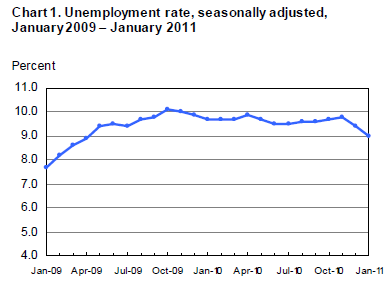Austrian economics, beer tasting, current topics, guest posting, and Dodgers baseball.
Sunday, April 17, 2011
Private Sector Job Growth: Before and After the Recovery
This graph is making its rounds about the internet, especially by Obama supporters and progressives in general. It is meant to show that the stimulus was successful and that our economy is doing well again. Unfortunately, though, and most seem to forget this, especially in politics, that correlation does not prove causation. I will now show that the conclusions reached in part by this graph are fallicious.
What is probably very important to look at is seasonally adjusted unemployment rates. Why is this important? Well, during certain times of the year we should expect higher employment than the rest of the year. Think of Christmas and all of the temporary workers that are hired to deal with all of the shopping going on. So what can we conclude from this graph? Unemployment does not seem to be decreasing at all. Rather, it has just stayed stubbornly high. Furthermore, how much are we not seeing in this graph by excluding those who are no longer listed as unemployed by the U-3 definition? Should unemployment, then, still be rising?
More importantly, how valuable are these jobs that have supposedly been created? Are they worthwhile jobs, are only fueled by government investment? In the Soviet Union, everyone had jobs, but everyone starved because people were not making what consumers wanted. How do we know that these jobs are necessary? The point of the stimulus is to create jobs by government investment, and jobs created as a result are independent of consumer demand. By all account, then, these are worthless jobs, and the investment that is used on these jobs is wasted as it could have been used to furnish a job that people do want done.
Finally, and most importantly, what assurance do we have that this is due to the stimulus? I could just as easily say that the growth is occurring despite the stimulus. These are two equally valid conclusions to draw from the graph. And it does not even answer the most important question: is quality of life starting to rise? I could imagine a country where everyone produces war goods. It would have the highest GDP, highest average wages, highest growth in income, etc. However, those people would be miserable. There would be no food, no consumer goods, nothing that makes life good. The statistics would be good, but the economy would be in terrible shape. Always keep that in mind when looking at economic indicators. Nothing can show you objectively quality of life, but theoretically, we know what it takes to achieve it. We need people who will do the jobs that people want done, we need competition to ensure low prices, and we need entrepreneurs and investors to make sure that we are investing in the best things possible. Under Obama and many other presidents of this and the last century, frankly, this has been opposed. So do not be persuaded by fancy statistics. We know the truth, and empiricism cannot overturn logic.
Subscribe to:
Post Comments (Atom)



it would be interesting to see job growth as a percentage of the potential workforce. I doubtthe jobs growth has been enough to cover the new young people that have become of age to work. Also, I suspect that the only reason unemplyment appears to be improving is due to people giving-up loking for work.
ReplyDeleteThis is why we should use a broader measure such as U6 unemployment, or even the Gallup measure of unemployment is much more accurate than U3.
ReplyDelete